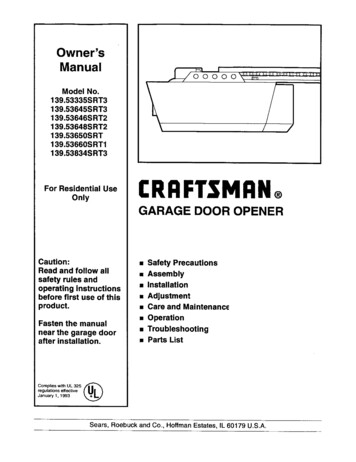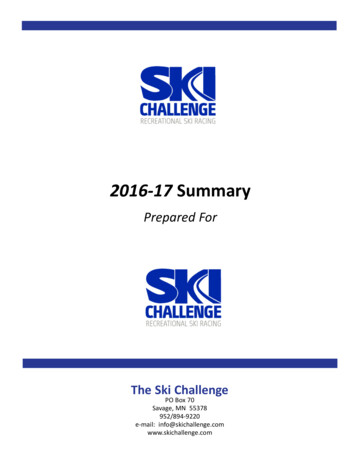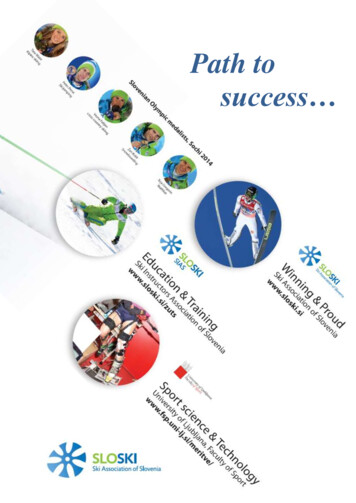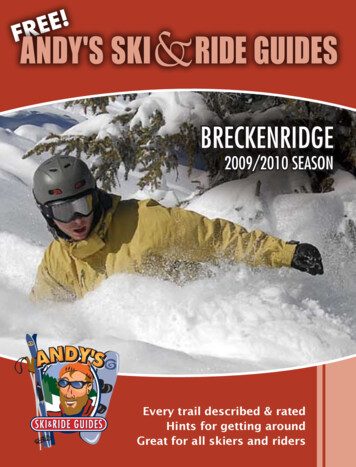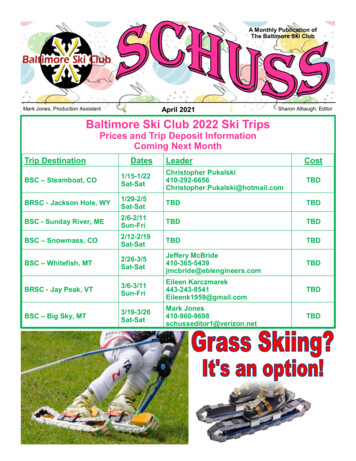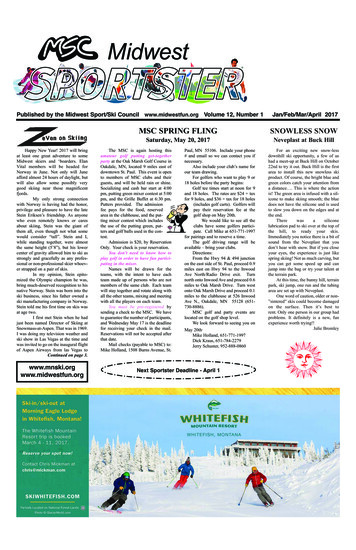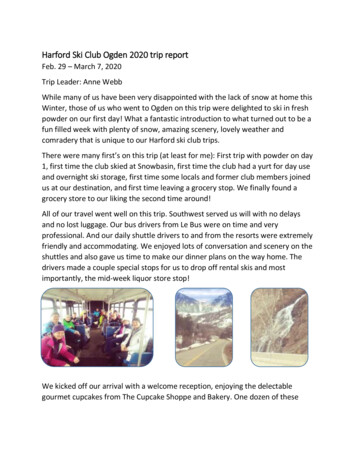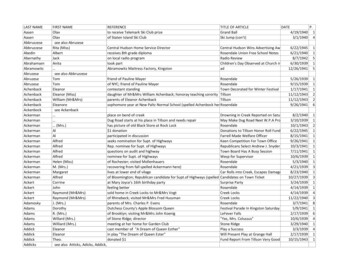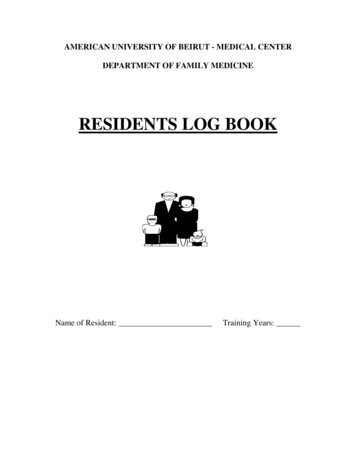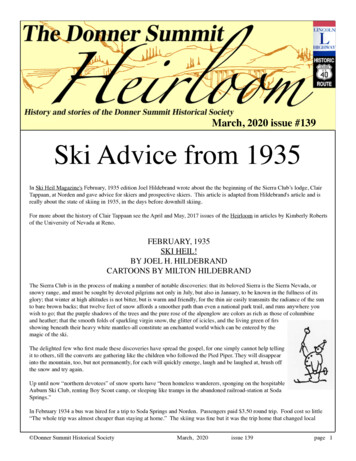
Transcription
March, 2020 issue #139Ski Advice from 1935In Ski Heil Magazine's February, 1935 edition Joel Hildebrand wrote about the the beginning of the Sierra Club’s lodge, ClairTappaan, at Norden and gave advice for skiers and prospective skiers. This article is adapted from Hildebrand's article and isreally about the state of skiing in 1935, in the days before downhill skiing.For more about the history of Clair Tappaan see the April and May, 2017 issues of the Heirloom in articles by Kimberly Robertsof the University of Nevada at Reno.FEBRUARY, 1935SKI HEIL!BY JOEL H. HILDEBRANDCARTOONS BY MILTON HILDEBRANDThe Sierra Club is in the process of making a number of notable discoveries: that its beloved Sierra is the Sierra Nevada, orsnowy range, and must be sought by devoted pilgrims not only in July, but also in January, to be known in the fullness of itsglory; that winter at high altitudes is not bitter, but is warm and friendly, for the thin air easily transmits the radiance of the sunto bare brown backs; that twelve feet of snow affords a smoother path than even a national park trail, and runs anywhere youwish to go; that the purple shadows of the trees and the pure rose of the alpenglow are colors as rich as those of columbineand heather; that the smooth folds of sparkling virgin snow, the glitter of icicles, and the living green of firsshowing beneath their heavy white mantles-all constitute an enchanted world which can be entered by themagic of the ski.The delighted few who first made these discoveries have spread the gospel, for one simply cannot help tellingit to others, till the converts are gathering like the children who followed the Pied Piper. They will disappearinto the mountain, too, but not permanently, for each will quickly emerge, laugh and be laughed at, brush offthe snow and try again.Up until now “northern devotees” of snow sports have “been homeless wanderers, sponging on the hospitableAuburn Ski Club, renting Boy Scout camp, or sleeping like tramps in the abandoned railroad-station at SodaSprings.”In February 1934 a bus was hired for a trip to Soda Springs and Norden. Passengers paid 3.50 round trip. Food cost so little“The whole trip was almost cheaper than staying at home.” The skiing was fine but it was the trip home that changed local Donner Summit Historical SocietyMarch, 2020issue 139page 1
Story Locations in this IssueClair Tappaan Lodge, pge 1weather station, pge 9cairn, pge 20Avalanche pge 18editor:Bill ciety.orgProofread by Pat Malberg, Lake Mary, DonnerSummitpage 2Unless otherwise noted, the photographs and other historical ephemera in TheHeirloom's pages come from the Norm Sayler collection at the Donner SummitHistorical Society Donner Summit Historical SocietyMarch, 2020issue 139
Clair Tappaan Lodge todayhistory. They talked of skiing, technique, and equipment of course but the most lasting subject was “where to spend the nighton future trips. The obvious answer was a ski-lodge, owned and operated by the Sierra Club, and the Clair Tappaan MemorialLodge” started to take shape in their minds. Walter Ratcliff, an architect, had already designed the Sierra Ski Club Lodge atNorden (now Hutchinson Lodge) and he offered his services.Norden was chosen because it is on the railroad line and the Lincoln Highway, which by then was U.S. 40 and was kept open allwinter, there was a post office, a store, and a public garage. Snow conditions were good too, “It lies at an altitude of 7000 feetand has one of the heaviest packs of snow in the United States; twelve feet is normal in February and twenty-seven feet is onrecord - plenty to fall in.”Ski Heil“Norden is only a mile west of the main crest of the SierraNevada. Ideal skiing slopes lie in every direction. Fourmiles to the north stands Castle Peak, a massive, palisadedThe winter greeting in the Alps is "Ski-heil." Heilmountain 9140 feet high, and three miles to the south ismeans health and happiness; it means long life andMount Lincoln, 8400 feet, whose north side encloses thegood luck; it means wholesomeness. The ski-runner"Sugar Bowl," (which in four years would become Sugarknows that only on skis can these be realized in theirBowl ski area) a smooth, shaded cirque surmounted byfullness. Come to the mountains! To the Sierra Nevada,fine pinnacles and collecting enough snow to last throughJune. The forest is open, and there are many slopes, withwhere the air is crisp and the sun is bright, wherebut few obstacles to fast running. A magnificent coursethe only depressions are those that one takes with awith a thousand-foot drop in altitude has been discovered,flourish and whoop! Strap on your skis and shout withdown the slopes of Mount Lincoln. Two of our skiersus, "Ski-heil"!ran it in five and a half minutes last March in un-trackedsnow.” A lease had been obtained from the Forest Serviceas well. Permission was granted to cut trees. Peoplestarted to contribute money. The Sierra Club voted moneyfor the project. Fixtures were donated. Fund raisers were held. Workers were rounded up as were “girls to cook for them” [lifewas different in those days for the “girls.”] Every weekend all spring and summer workers traveled to the summit to work.By the time of Hildebrand's article the lodge was a reality only waiting for a permanent roof the next year. Meanwhile lots ofpeople had signed up to use the lodge and there were plans to add to the facility.Skiing BadgesIn order to take “full advantage of the facilities” skiing proficiency was a necessity and so the SierraClub “adopted the official test of the British Ski Club.” There were three classes of badges. The firstwas for winners of international races. The second was very severe and not many would qualify.The third class would be earned by a “rather good skier, well equipped for all ordinary touring”(this was not the age of downhill skiing yet.) “To earn it one must demonstrate climbing ability andstamina, telemarks, christianias, and continuous stem-turns on a gradient of 15 degrees, and run down Donner Summit Historical SocietyMarch, 2020issue 139page 3
a standard 1000-foot course within a fixed time limit, usually about seven minutes, but varying withsnow conditions.”Then to encourage beginners a fourth class was established. It was “designed to demonstrateability to join in an easy tour without likelihood of having to be carried home. The fourth-class skiermust ascend and descend 500 feet within specific time limits. He must demonstrate kick-turns, foursuccessive stem-turns, a snow-plow to a stand-still and a short, straight run.”The club’s philosophy was, “It should be the ambition of everyone to pass at least the third-class test. Thesatisfactions of skiing confidently under control are very great. Do not emulate those who go wildly downa steep slope out of control, waving arms and legs madly, holding poles so that a fall threatens impalement,only to crash to a mass of wreckage long before reaching the bottom.No one who can use his legs should fear to try skiing. The first couple of days are very awkward, for one'snatural reflexes are of little use and a new set must be acquired; but this need not take long, and it begins tobe fun very soon. It is fun for those who watch you, right from the start.Equipment and Clothing AdviceHildebrand had “seen people trying to learn on skis afoot too long, with soft moccasin-toed boots that wobbleabout in the bindings so that the skis cannot possibly beguided. It cannot be done in that way. One simply must have proper bootsand bindings, with skis of the right length. It will pay, in the long run, to buyreal ski-boots with stout soles and square, hard toes. They are not cheap, butwill last a lifetime, and the satisfaction one gets from them will justify cuttingdown on some expensive vice in order to own a pair.Joel Hildebrand was a chemistry professorand dean at the University of California atBerkeley, U.S. winter Olympic team manager,president of the Sierra Club, charter memberof the Auburn Ski Club, and a founder ofClair Tappaan Lodge. Hildebrand Hall atU.C. Berkeley is named for Dr. Hildebrand.“They should be big enough to permit two pairs of heavy wool socks; and still allow you to wiggle your toes. Do not drenchthem with oil, but wax them a couple of times a season. Keep them on lasts when not in use.“The skis should be of ash or, better, hickory, and not longer than from the floor to the palm of the upstretchedhand. The grain should be either vertical or else strictly horizontal throughout. Bindings should fit the bootperfectly, permitting no side-play of the heel, but allowing it to be lifted freely far enough to kneel on the ski.Bindings with toe-straps are easier on the boots, and far more practical than those which clamp the sole. You will need a pair of ski-sticks, also canvas mittens and woolen mittens to wear under them when the sundoes not shine. Provide yourself with four kinds of ski-wax: for cold dry snow, for wet snow, for crust, and for"corn-snow," which is coarse, granular spring-snow. The purpose of wax is to enable one to slide downhill freelywithout sticking, and yet to climb up-hill with sufficient sticking to prevent back-slip.“ A small cake of paraffin is useful if the other waxes have not prevented the adherence of snow to the skis.Trousers may be either knee-breeches or long trousers, of the Norwegian type, tied at the ankle. Riding trousers do not allowenough knee-room. In either case they should be of wool, closely knit, with smooth finish. Lightwaterproofing is advisable. Do not bundle yourself in heavy underwear, for skiing is often hot work.Wear a light flannel shirt and depend on sweater and wind-jacket, carried along in your rucksack, forprotection against cold on an exposed ridge or in the late afternoon. Your cap or hat should furnishgenerous protection against the sun; but provide yourself in addition with goggles and theatrical greasepaint. This last is far superior in effectiveness and sticking quality to other face-dopes. The burningpower of sunlight in snow at 8000 feet in March cannot be overestimated.“Always take your rucksack if you are going more than a mile fromthe lodge. Put into it your sweater, wind-jacket, woolen mittens, wax, acouple of straps, lunch, a can of tomato-juice, first-aid for yourself andskis, flashlight, and matches. An aluminum ski-tip may prevent yourbeing marooned miles from home.page 4 Donner Summit Historical SocietyMarch, 2020issue 139
Safety AdviceHwy 40 Scenic Bypass“Never go off alone. An accident which may be only a minor one toa member of a party becomes a major one to a lone skier.“Each party should have a responsible leader and a rounder-up, andnoses should be counted at intervals. Do not court danger; if not foryour own sake, at least as a courtesy to others, for injury to eitheryou or your skis makes you a nuisance. Learn something aboutavalanches, and avoid a possible avalanche slope as you would theplague. Every slope of 25 degrees or more is dangerous after a newfall of powder snow; also when the snow is very wet.Final Advice“Do not allow yourself to be deterred by the dangers of skiing.These can be minimized by knowledge and judgment so that theyare no more serious than the hazards of motoring, which deter noone.Clair Tappaan LodgeHistoryClair Tappaan Lodge was hand-built by a hearty group of SierraClub volunteers in 1934 as a retreat for hikers, skiers and mountain climbers. This rustic building, consisting of post and beamconstruction, was designed by Walter Ratcliff, a noted Berkeleyarchitect and member of the Sierra Club. The superstructure ofthe lodge consists of large vertical logs with a rough-sawn beamroof structure from timber felled on the site. Volunteers expanded the building several times and maintain it today.The lodge is named after Sierra Club President andSuperior Court Judge Clair Tappaan.A Good StoryNed Robinson was seven years old when Clair Tappaan Lodge was built. His job was to stand on therunning board of an old Ford truck (right) and relayrequests for the vehicle to move in order to raise thebeams. There is a video of the bare-chested youngmen building the lodge with hand saws and hammerswhich can be viewed on the lodge websitehttp://ctl.sierraclub.orgThings to do right hereYou can enter the building and view the enormous timbers (above) used in the initial construction. Thecozy library has a display of historic photos, books of Donner Summit history, and early-day visitor’slogs.The friendly, casual atmosphere and affordable nightly rates (including family-style meals) make thelodge the perfect rustic getaway and a charming spot from which to explore the riches of the Sierra Nevada.In summer, the recreational opportunities are unlimited. A network of nearby trails offers miles ofhiking and provides access to remote meadows and peaks, crystal clear lakes and numerous fishingstreams. The well-known Pacific Crest Trail is only a mile away. The Donner Summit area is great forboth road and mountain biking. It is also widely known as a rock climbers’ mecca.The area receives the highest average snowfall of the entire Sierra Nevada range, making the lodge afavorite with cross-country ski and snowshoe enthusiasts. In winter you can rent skis or snowshoes toexplore the many groomed trails, take weekend classes, or sled on the hill behind the lodge.“I would urge our ardent mountain climbers to restrain theirambitions to climb peaks in winter till they have learned to ski. Oneshould be ashamed to make a long descent by 'sitzmarking' at everyturn when it should be possible to run down under control in a beautiful series of christianias or telemarks. To one who haslearned to ski, it is this, not the mountain-peak, that is the greater glory.This sign sponsored by Clair Tappaan Lodgeand the Sierra Clubpictured here top: contemporary picture of the main hallway.Middle and bottom: original construction pictures and 1930’s skiers in front of Castle Peak.The black and white photographs are from the Clair Tappaan scrapbook.copyright 2010 Donner Summit Historical Societywww.donnersummithistoricalsociety.orgThe Ski Heil article from which this was written came from long time subscriber ChuckOldenburg in November, 2017. There's just so much Donner Summit history vying forinclusion in the Heirloom that much has to wait its turn. Donner Summit Historical SocietyMarch, 2020issue 139page 5
Crazy or What?!Our February Heirloom had one of our "What's in Your Closet?" stories about a 1915 trip over Donner Summit by LeonChamberlain. At the end of the article, by Rich Chamberlain, there was a note that the Stanley Steamer had participated in oneof the annual races of automobiles over Donner Summit. Contestants were aiming to be the first to cross the mountains eachspring. Who could be first to conquer the melting snow? Leon didn't win because he did not know about the tricks that veteranracers employed. Rich Chamberlain said,"this race had been an annual event for several years and many of the participants knew tricks and techniques to helpthem over patches of snow. Some of those entered in the race carried large planks of wood in their cars to place on topof the snow. Other drivers had winches and apparatus that enabled them to get their cars on top of the snow sheds forthe trains."You can see the kind of thing Rich is talking about if you go to theJune, '19 Heirloom for the story of Arthur Foote in 1911 who didwin that year (see also the Heirlooms for July, '14 and June, '15).Looking at the pictures on these two pages or in the Heirloomslisted above you can get an idea of the difficulty of being the firstor even just an early crosser of Donner Summit. What wouldinduce someone to attempt such an "adventure?"First let's deal with who was encouraging this sort of thing.Snow is a problem on Donner Summit and closed off automobiletravel for months each winter and spring until the State startedclearing the highway in 1932. Merchants in Tahoe and Truckeeand beyond were interested in getting summer tourism goingas soon as possible. They held snow shoveling bees and hiredsnow shovelers to dig trenches to expose more surface areaAbove, the Chamberlain Stanley Steamer near Donnerto speed melting. They collected ashes to spread on the snowSummit in 1914 on another trip through the snow.(see examples on page 8) and they spread salt. In the early 20thCentury the Tahoe Tavern held an annual silver cup race which attracted contestants, but more importantly attracted publicityfor travel. There were newspaper articles that reported on the state of the roads and when they would be officially openedwhich also garnered interest.Then there were the early automobile manufacturers and dealers. They wanted the publicity of their automobiles being the firstover the summit and down to Lake Tahoe. Showing the ruggedness should increase sales. The auto parts manufacturers joinedin too touting that their tires, for example, that helped the winning automobile to first place. Early 20th Century newspaperarticles carried titles like, "Buick Auto FirstOver Sierra Road" (1917 - the driver, a Mr.McGee, had been in the race a couple oftimes), "Overland Bests Mud in Run to LakeTahoe (1913), "Tiny Maxwell Car WinsTahoe Cup (1911), "Little Ford Wins TahoeCup" (1911). (Despite the conflict in 1911those are accurate dates for articles.)The newspapers dutifully reported on therace winners and other attempts to crossthe Sierra. No doubt those kinds of storiesabout that new thing, the automobile,increased circulation. The catchy titles nodoubt attracted readers, "Plucky Buick PilotReturning After Completing Dangerouspage 6 Donner Summit Historical Society1916 Chalmers conquering Donner Pass with help.March, 2020issue 139
Trip" (1912), "Plow Through Snow Drifts Near Summit"(1917), "White Mantle Covering Crest of SierraMountains Fails as Barrier to Progress of Sturdy TouringCar" (1912, "Auto Stalled by Snow in Sierra" (1910 - Thedriver and friends got stuck and walked to the summit.So the attempt to be the first auto was a failure. Thearticle went on to say they could have shoveled their wayout but were in a rush to get home and so did not do that.Apparently they left the car in the snow?)Then we've got to address the drivers. Why did theyattempt the crazy adventures? Many no doubt did notknow any better about what the conditions really were.Arthur Foote, who won the 1911 race for the TahoeTavern silver cup (in a Ford) went back to Nevada Cityto get more equipment so he could continue. People also Unidentified "autoists" crossing on top of the Donner Summitdidn't believe the amount of snow on the summit or howsnowsheds. When the snow covered the barn doors that allowedslowly it melts. In 1884 Thomas Stevens rode his bicycle vehicles to cross the tracks by going through the sheds, or later theacross the Sierra leaving San Francisco in the spring. He snow covered the underpass, this was the only alternative to waitinghad no idea there would be so much snow and ended upfor snow melt.crossing through the snow sheds. George Wyman did thesame thing in 1902. He'd also left San Francisco in the late spring and did not know there would be so much snow. AlexanderWinton and his driver did likewise in 1901, also having left San Francisco in the spring driving their Winton automobile. Theydidn't go through the snowsheds however. They went over them.What would induce a man (they were all men in this endeavor although there were women "Transcontinentalists" - See "WomenCrossed Donner Summit Too" in the March, '16 Heirloom). Clearly some at least didn't know what they were getting into.Most, though probably did know. The journey today is measured in hours in sealed automobiles. In the early 20th Century thejourney could be weeks in the early season. The automobiles didn't even have tops and so the participants were at the mercy ofthe elements. They had to sleep outside because there were few lodgings. It was best to travel at first light while the snow wasstill frozen so tires didn't sink, and so it was cold out. There was a lot of physical exertion. There was a lot of digging. Therewas a lot of heaving and sweating using winches and pushing. Some, as Rich Chamberlain's article notes, carried boards. Laythe boards down. Drive over them. Lay another set of boards, drive over those and remove the first boards. Step by Step overthe snow. Others carried canvas which did the same thing.All of that to conquer the Sierra and be the first for the season. There were bragging rights no doubt and for some years therewas a Tahoe Tavern silver cup.Then there is testosterone. These were allguys with new toys. How far could the newtransportation, the automobile, go? Newspapersreported on endurance runs and races. DonnerSummit wasn't unique. And testosteroneencourages guys to do things just becausethey can. Arthur Foote's 1911 expedition wasbecause of a bet.i.e. raising money to fund snow clearing overDonner SummitSanta Cruz Evening News June 8, 1917Here's the Chalmers again. Note the guys on ropes in the back Donner Summit Historical SocietyMarch, 2020issue 139page 7
Arthur Foote "driving" over the snow to his Tahoe Tavern win in 1911.Truckee Republican May 25, 1916Oakland Tribune May 31, 1914San Francisco Examiner May 28, 1914The trip will encourage others?“ .the success of these three men in first crossing the Emigrant pass summit shows that the late winter touring afforded bythe Sierras is making an appeal for the first time to private owners. Heretofore, the earliest crossings have always been made bydealers with intent of demonstrating their cars.”Leon J. PinkstonSan Francisco Call june 15, 1911Mr. Pinkston wrote an automobile column for the Call. Here he's talking about Arthur Foote's trip.page 8 Donner Summit Historical SocietyMarch, 2020issue 139
What's in Your Closet?Donner Summit Weather Station CtollectionRick Solinsky posts a lot of historic pictures on our DSHS FaceBook page for which we are grateful. He’s helping spread thestory of Donner Summit history and those posts attract a lot of interest.Early in the summer of 2019 he posted a picture of the weather station that serviced the first transcontinental air route over DonnerSummit. Pam Vaughan saw the weather station picture and it struck a cord in her because her father, Willard Milligan, had workedthere. Better, she had pictures, and best, she wanted to share.She sent us a CD titled, “Donner Summit Weather Station 1939-1941 Willard Ellis Milligan Pam Vaughan Bishop CA ”Pam said that her father “loved his job there in about 1939-1941 but maybe didn’t enjoy the deep snow! He took lots of photosand loved camera equipment.”“Dad was Willard Ellis Milligan, and his wife was Helen (Partridge). Dad was born in 1912 and died in 2005.Mom was born in 1917 and died in 2007. They often talkedabout their time living in Truckee and trudging through thesnow up to the weather station on Donner Summit. One ofthe photos shows the walking route in the snow. Apparentlythere was a garage [page 15] at the bottom of the hill wherethey could park their car. Mom related that she once wastaking a berry pie up that route to the ‘boys’ and fell facefirst into the pie and the snow. They told lots of stories aboutliving there.“They lived by the railroad tracks [down in Truckee] in atiny 1 bedroom house. One day a terrible smell emanatedfrom the bathroom next door. The poor guy had died on thetoilet several days previously. Yep, they told stories like that!“Dad was a radio man and had learned Morse code andgotten his amateur radio license while still in high schoolin Fresno. He proceeded to join the U.S. Navy Reserve andthen the Army Reserve. He then joined the CCC [CivilianConservation Corps] and was working as a radioman for thatfederal entity when he met my mom. They married and livedin Fresno, then Sacramento and then Truckee. In August of1941, he got a job with the State of California as a radio technician, so they left Truckee. But he always had aradio station in his yard and house after that and was sending Morse Code and CQs the day he died at the age of92! His call letters were W6DQR.“I’ve left my dad’s captions from the photo album on the scanned images. Some of these, I believe are RPPCs(Real Photo PostCards), commercially produced. Amidst the photos are receivers in Fresno. These might bereceivers for the weather station or perhaps they were from before Dad worked on Donner. But he seemed toalways put things into sequential order.“Claude Herrold was the boss while he was working on the summit. Another person from the photo is someonenamed ‘Edgar.’“Thanks for taking care of the Donner Summit history! I am a photo archivist and researcher at the Laws Museumand Historic Site in Bishop, California. I also am a history columnist for our local paper, the Inyo Register.Pam Vaughan Donner Summit Historical SocietyMarch, 2020issue 139page 9
weather station site today - picture by George LamsonOAKLAND-RENO AIRWAY"our transmitter house"The Donner Summit radio range* on theOakland-Reno airway will be located 8000 feethigh astop [sic] the Sierra “hump.” Airwayengineers for the department of commercehave selected a site for the mountain range nearthe airways [sic] weather reporting station atthe Summit. This range will guide flier overthe Sierra on the western dvision [sic] of thetranscontinental airway.Oakland Tribune June 12, 1930*radio broadcasting to enable pilots to find their positionsusing specific signals that carryidentification but also valuespilots could use."Out of our kitchen window atthe summit."page 10 Donner Summit Historical SocietyMarch, 2020issue 139
"The hiway station from the airwaystation."The octagonal building used to houseDivision of Highways equipment andcollapsed in the 1980's"Big Shot inspectors having a snow ball fight"To read more about the weatherstation or the transcontinental airroute on Donner Summit, there isour 20 Mile Museum sign on thenext page (on our website as wellas on Donner Pass Rd. after snowmelt.Take a look too at our article andpicture indices on our web site.See the Heirloom:September 2018July, 2011December, 2016There's also an exhibit on ourexhibits page Donner Summit Historical SocietyMarch, 2020issue 139page 11
"Our thermometer box"One of our 20 Mile Museum signs which you can visit after snowmelt and through summer and fall on Donner Pass Rd. at the top ofthe pass. (It's on our website too)Our ceiling projector lamp."Our five receivers at Donner Summit."not labeledpage 12 Donner Summit Historical SocietyMarch, 2020issue 139
Left, "My Little Eskimo"Left, "One of the few pictures of theboss"Right, "A certain man with a certainwoman The reason why certain operatorswere late to work""'Sparky' the Chevvy & me"Right, "Whatis she lookingat?"Left, "The rear of theboss"Right, "Our Post officein the Spring with nosnow" Norden Storeand Ski Lodge Donner Summit Historical SocietyMarch, 2020issue 139page 13
"Thunderstorm over the sugar bowl hill""6 people and none were hurt"Presumably this car went off the edgeof Old 40 as some did from time to timeattested to by the wreckage that's stillthere.The Business end of a Snow Plow""When we cracked up theChev" Note the ski jump inthe background.page 14 Donner Summit Historical SocietyMarch, 2020issue 139
"Our garage at Donner"Mr. Milligan took apicture of a postcardhere."The Dodge under Four Feet of Snow"The garage, November, 2019"Looking down the grade" also a postcard"The Queen ofDonner" Donner Summit Historical SocietyMarch, 2020issue 139page 15
"Looks like Alaska but its California" postcard ofTruckee, 1941"Our path downtown" postcardpage 16 Donner Summit Historical SocietyMarch, 2020issue 139
Video ReviewMastering the MountainsPlacer County Museums, 10 minutesThe Placer County Archive is a repository of 30,000historical photographs covering all of Placer Countyincluding Donner Summit. The Heirloom has used theirphotographs more than once. You can visit the archives tosee their material – see below.Recently the Placer County Museums staff decided to makethe archives available to people who can’t visit or don’tknow what to look for. They are planning a series of “tenminute single subject videos” about Placer County history.The first one, “Mastering the Mountains” is now out. Youcan see it by going to YouTube and search for “Masteringthe Mountains.”The short video is a wealth of pictures leading to andconstructing the transcontinental railroad using Ken Burnstechniques as the view pans around and zooms in andout of old photographs, modern scenery photographs,illustrations, and paintings. If you are familiar with theconstruction of the railroad you won’t learn anythingnew but you’ll enjoy the photographs. If you don’t knowmuch about the construction the video serves as a goodintroduction.There are many pictures of the summit and good short summary of the building of the railroad over Donner Pass. The videocovers, for example, Judah’s miscalculations about snow not being a problem which of course, brings up snowsheds and thebuilding of Tunnel 6 and its central shaft.Placer County Museums publishes a bi-monthly newsletter about what’s happening in the Placer County Museums. https://www.placer.ca.gov/2489/Museums. It was the November-December, 2019 issue that carried the announcement of PlacerCounty Museum’s first video and in that announcement article the thought process in developing the story was laid out.It turns out producing an historical video requires a lot of thought first, "When you’re dealing with an event that was a fightagainst seemingly insurmountable odds, it naturally begs to be made into a hero’s journey. With that in mind, when you’repitting man and machine against rugged terrain and the terrain ultimately loses the fight, in some ways it makes the county itselfthe villain. Maybe not a villain like Darth Vader but defi
In Ski Heil Magazine's February, 1935 edition Joel Hildebrand wrote about the the beginning of the Sierra Club's lodge, Clair Tappaan, at Norden and gave advice for skiers and prospective skiers. This article is adapted from Hildebrand's article and is really about the state of skiing in 1935, in the days before downhill skiing.
